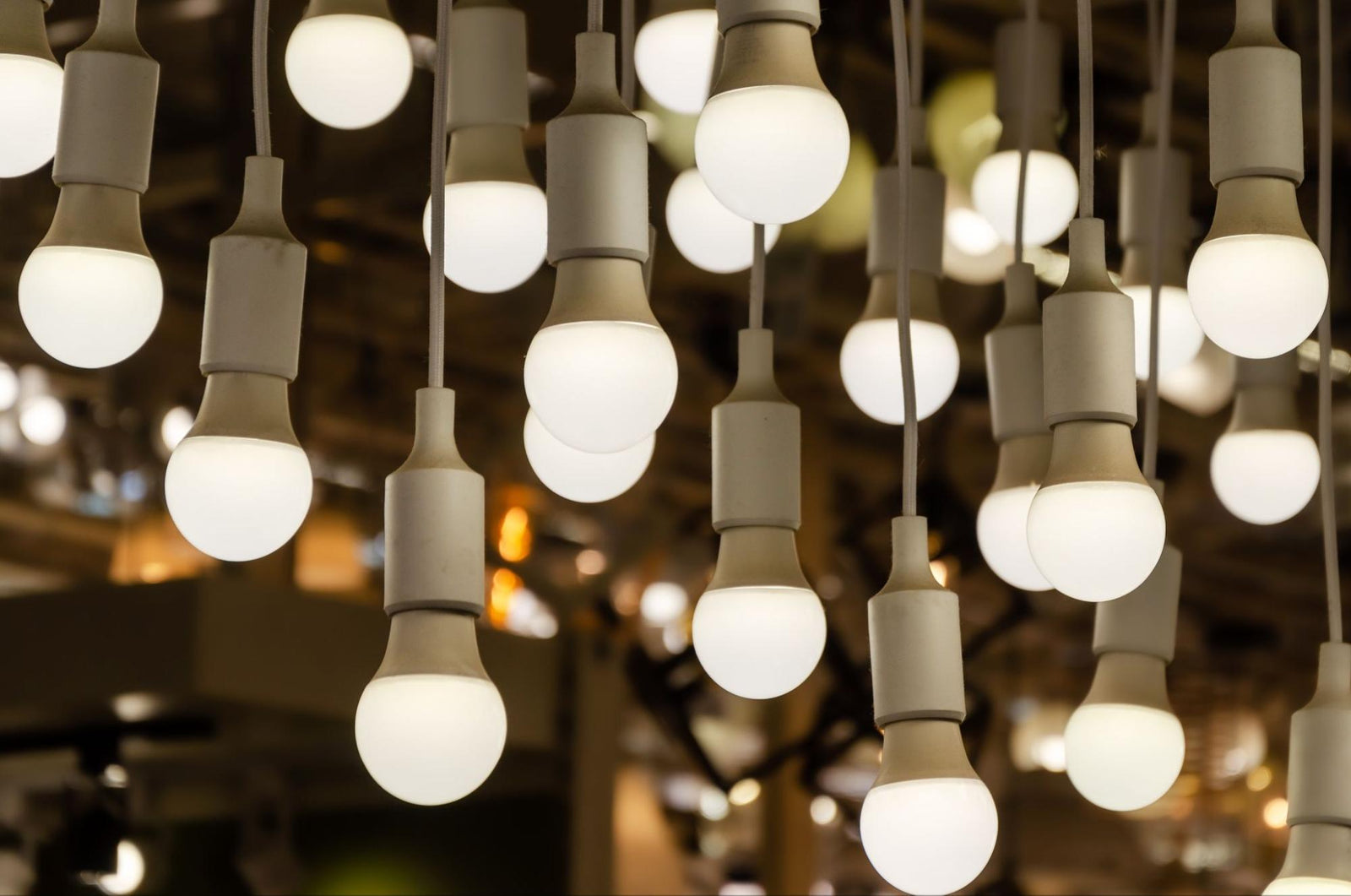With rising energy costs and growing environmental awareness, many people are considering switching to LED lighting but want to ensure it's a worthwhile investment before making the change — and so the question arises: how long do LED lights last?
LED lights commonly last between 25,000 and 50,000 hours, with some high-quality models reaching up to 100,000 hours in ideal conditions.
This extended lifespan can greatly reduce long-term costs by minimizing replacements, while also offering notable environmental benefits through lower energy usage and less waste.
While this lifespan is impressive, it's important to note that several factors can significantly impact how long your LED lights will actually last in real-world conditions. Understanding these factors can help you maximize your investment and ensure your lights perform as expected for years to come.
What Factors Affect LED Light Lifespan?
Several key factors can either extend or reduce the lifespan of your LED lights. Temperature is perhaps the most significant - LEDs perform best in cool environments and can degrade faster when exposed to excessive heat. Poor heat dissipation in enclosed fixtures or outdoor locations with high temperatures can significantly reduce their longevity.
The quality of the power supply also plays a crucial role. Voltage fluctuations and poor-quality drivers can cause premature failure. Additionally, frequent switching (like turning lights on and off) can impact lifespan, though LEDs typically handle this better than traditional bulbs.
How Can You Make LED Lights Last Longer?
To maximize LED lifespan, start by ensuring proper installation in well-ventilated fixtures that allow heat to escape. Choose fixtures specifically designed for LEDs rather than retrofitting old fixtures meant for incandescent bulbs.
Consider installing dimmer switches compatible with LED technology, as this can reduce power consumption and heat generation. Regular cleaning to prevent dust buildup and maintaining a stable power supply through surge protectors can also help extend LED life.
How Do You Know When LED Lights Are Nearing End Of Life?
Unlike traditional bulbs that suddenly burn out, LEDs typically experience gradual lumen depreciation. What this means — to put it in everyday terms — is that you might notice the light becoming progressively dimmer over time. Most LEDs are considered at “end-of-life" when they reach 70% of their initial brightness.
Some LEDs may also show signs of color shifting, where the light appears more yellow or blue than when first installed. In some cases, individual diodes within the LED might fail, causing uneven lighting or flickering. These signs indicate it's time to start planning for replacement, even though the LED might continue functioning at reduced capacity.
Are LED Lights Worth The Higher Initial Cost?
While LED bulbs typically cost more upfront than traditional lighting options, they usually pay for themselves through energy savings within 1-2 years. LEDs use approximately 75% less energy than incandescent bulbs and last up to 25 times longer, resulting in significant long-term savings.
Light bulb moment: Consider a typical 60-watt equivalent LED bulb costing $3-$8. Over its lifetime, it can save $30-$80 in electricity costs compared to incandescent alternatives. Additionally, the reduced frequency of replacements means fewer purchases over time and lower maintenance costs, especially in hard-to-reach areas.
How Do LED Lifespans Compare To Other Light Bulbs?
The lifespan difference between LEDs and other lighting technologies is striking. While traditional incandescent bulbs typically last only 1,000-2,000 hours and halogen bulbs about 2,000-4,000 hours, even basic LEDs outlast them many times over.
Compact fluorescent lamps (CFLs) fare better, lasting around 8,000-15,000 hours, but still fall far short of LED longevity (typically in that 25,000 - 50,000 range). This dramatic difference in lifespan means that you would need to replace an incandescent bulb 25-50 times, or a CFL 3-6 times, during the lifetime of a single LED bulb.
The longer lifespan of LEDs not only saves money but also reduces waste and the environmental impact of manufacturing and disposing of multiple replacement bulbs. This makes LEDs an increasingly popular choice for both residential and commercial applications where maintenance efficiency is a priority.
What About LED Lighting for Vehicles?
At Ultra Bright Lightz, we built a brand on led lighting for vehicles, though we also offer additional everyday lighting options. With that said, we know a thing or two about high-quality LED lights for vehicles. Before diving into the details of LED lifespan, it helps to know why so many drivers are making the switch to LEDs:
-
Enhanced Visibility
LED headlights and fog lights offer brighter, more focused beams. This can increase your visibility at night and in adverse weather, improving safety. -
Lower Power Consumption
LEDs draw significantly less current than halogens or older incandescent bulbs, reducing strain on your vehicle’s electrical system and alternator. -
Longer Lifespan
The extended life of LEDs means less hassle replacing bulbs—especially useful for hard-to-reach headlight assemblies or specialized interior lighting. -
Aesthetic Appeal
LEDs have a modern look, with crisp colors for daytime running lights, interior accent lighting, and taillights.
With these benefits in mind, understanding how to care for and maintain your automotive LED bulbs ensures you get the most out of your investment.
What Factors Affect LED Light Lifespan in Vehicles?
Although LEDs are designed to be robust and long-lasting, certain factors can accelerate wear and reduce their total operating hours—particularly in the demanding environment of a vehicle.
1. Temperature and Heat Dissipation
Heat is the number-one enemy of LED longevity. In cars, engine bay temperatures and proximity to hot engine components can be significantly higher than typical indoor environments. When an LED assembly is used in a cramped headlight housing with inadequate ventilation or in proximity to other hot parts, the internal temperature of the LED driver and diodes can climb.
-
Why It Matters: Excessive heat causes the LED’s internal semiconductor materials to degrade more quickly. Over time, brightness diminishes, and the light may change color or flicker.
-
How to Manage: Choose automotive-grade LEDs with built-in cooling systems, such as heatsinks or fans. Proper installation—making sure there’s enough space for air to circulate—can significantly prolong bulb life.
2. Voltage Fluctuations and Power Supply Quality
In a vehicle, the electrical system is not always a clean, steady 12V supply. Voltage spikes can occur when the alternator kicks in or when other high-draw components (like the AC compressor or power windows) engage.
-
Why It Matters: Frequent or severe voltage fluctuations can stress the LED drivers, potentially causing premature failure.
-
How to Manage: Invest in high-quality LED bulbs with stable, well-designed drivers that protect against power surges. Some premium LED kits include additional resistors or capacitors to maintain current flow.
3. Vibration and Shock
Vehicles undergo constant motion. Potholes, speed bumps, and the general vibrations of the engine and suspension can all affect the internal wiring and connections within the LED assembly.
-
Why It Matters: LEDs themselves are more resistant to shock than filament-based bulbs (which can break easily), but poor-quality circuit boards or solder joints can still crack under repeated vibration.
-
How to Manage: Look for automotive-specific LEDs with rugged, vibration-resistant construction. Proper installation—ensuring the bulb is securely seated—also reduces wear.
4. Frequent Switching (On/Off Cycles)
Interior lights that turn on and off regularly—such as dome lights or door lights—go through many more cycles than, say, a headlight that stays on for extended trips.
-
Why It Matters: While LEDs handle rapid on/off cycles better than incandescent bulbs, extreme or constant cycling can still place stress on the driver circuitry over time.
-
How to Manage: This factor is generally minimal for automotive LEDs, but it’s another reason to choose reputable brands tested for longevity.
Taking the Next Bright Step
Now that you understand the impressive lifespan potential of LED lights and what affects their longevity, it's time to audit your current lighting setup. Walk through your home or workspace and identify any high-use areas still using traditional bulbs, as these locations will benefit most from an upgrade to LEDs and provide the quickest return on investment.
FAQs
How long do LED lights last on average?
Most LED bulbs are rated for 20,000 to 50,000 hours, which can translate to 10+ years of typical use. Their solid-state design offers a much longer lifespan than traditional incandescent bulbs.
Do LED lights flicker before they burn out?
Some LEDs may flicker or dim if their internal driver is failing or if there’s an electrical issue. However, flickering isn’t always a guaranteed sign they’re about to fail—often it’s related to voltage fluctuations or a faulty component.
Is it OK to leave LED lights on all day?
Generally, yes—LEDs produce less heat than other bulbs and use less energy, making them safer and more efficient for continuous operation. That said, any light left on 24/7 will experience faster overall wear, so turn them off when not needed to maximize lifespan.
How often should LED lights be replaced?
Under normal usage, you might only need to replace LEDs every 10–20 years (or more), depending on their daily run time and overall quality. It’s best to replace them once brightness noticeably declines or if they become unreliable.


